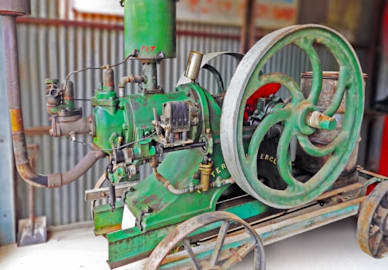Stock Crawler tractors were manufactured in Germany in the early 1920s following the successful Motor Plough made by the Stock-Motorpflug Ag earlier in the1900s.
This tractor is a front wheel drive crawler with clutch and brake steering. It is powered by a 28hp two cylinder petrol start-kerosene run engine which is coupled to a three forward and one reverse gearbox.

The tractors are rated as very rare; there are three running examples known in Australia, and the only others that are presently known are three restored tractors in museums in Israel, France and Hungary. Of the Australian Stocks, there are two in private collections, plus the one we have in the Tractor Museum in Whiteman Park, WA.
This particular tractor was first worked on by an enthusiastic member, Mr Phyl Wyndham who found most of the bits to make up the complete machine, with help from Peter Eades at Albany, WA, who also has one of the running tractors. Phyl restored the engine and gearbox and, when he was about to leave Australia to go and live overseas, he donated the restored engine and gearbox - plus a trailer load of sundry parts to the Museum. Along with the mechanical parts, he also generously donated $1,000 towards finishing the work he had started.

This tractor is made up with parts from three wrecked machines. Many of the parts were badly rusted and some had to be re-made. Two Museum members, Michael McGlahren and the late Robert Thompson spent many hours over 20 months, trying to work out where all the parts went. As Robert said in one of his reports, “It has not been easy working out just how the parts go together, since we do not have a very distinct service manual – possibly some small parts may be missing”. That was an understatement!!

The men persevered and, eventually sorted out the finer points to complete the work. When it came time to start the engine for the first time, it would not co-operate; the problem being fuel flooding the carburettor. Much time was spent on the situation and, finally, it was started by belt from another tractor.

It was music to the ears of Michael and those assisting when the heavy slow-revving motor was running under its own power. Some reports on the success of the tractor in the field were not encouraging, though. Apparently when pulling a side loaded implement such as a hay binder, the tractor continually wanted to turn away from the work, apart from trouble with the tracks tending to run off the drive wheels.

Nevertheless, the tractor is now on display in the Museum and attracts quite a lot of attention. *Ron Waterhouse










